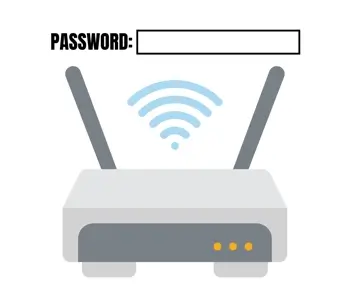What Is a WPA2 Password?
A good wireless connection is essential in our daily lives. However, having secure access to the Internet comes with some requirements. A WiFi password is one such requirement, keeping your devices and connection safe. In this article, learn what a WPA2 password is, how it works, and its role in WiFi networks.
What is a WPA2 password?
WPA2, short for WiFi Protected Access II, is the second generation of the WPA security protocol designed to secure wireless networks from unauthorized access. The password is the specific code you input to connect your devices to the network.
A WPA2 password is a security key used to protect WiFi networks. Introduced in 2004, WPA2 has become the standard for WiFi security due to its robust encryption methods.

When you set up a WiFi network, you receive a prompt to choose a security protocol and create a password. WPA2 is often recommended because it uses Advanced Encryption Standard (AES) encryption, which is highly secure. You must enter the WPA2 password for any device attempting to connect to the network, ensuring that only authorized users can access it.
The primary function of the WPA2 password is to encrypt data transmitted over the network. It aims at making the data unreadable to anyone who might intercept it.
The strength of your network's protection largely depends on the complexity of your password. Hackers can easily crack a weak password. Therefore, it is best to create a strong WPA2 password that is difficult to guess or break using brute force password attacks.
Your password should be as strong as possible. A general recommendation is to use a password of at least 16 characters long. Ideally, a mix of upper- and lowercase letters and special characters takes more effort to crack.
Avoid using easily guessable personal information like your name. Instead, opt for a unique yet easy-to-remember combination.
History of WPA2
The evolution of WiFi security has been a journey from vulnerability to robust protection. The original security standard for WiFi networks was called WEP (Wired Equivalent Privacy). Introduced in 1999, WEP promised the same level of protection as a wired connection.
Due to serious vulnerabilities, the WEP network was relatively easy for hackers to break. Users became vulnerable to anyone else who shared the same network because everyone shared the same key.
The shared key meant that anyone nearby could intercept any traffic on the network. WPA (WiFi Protected Access) was released in 2003 to improve WEP. It uses a 256-bit key for encryption, compared to the 64-bit and 128-bit keys used by WEP.
The difference in encryption strength means that hackers would take considerably longer to crack a 256-bit encrypted system than a 128-bit one.
WPA technology came with some advanced features, including accepting human-friendly passwords. It also introduced the Temporal Key Integrity Protocol (TKIP) to address serious vulnerabilities that were once present on WEP networks. TKIP made connecting to other network connections possible without exposing sensitive information to outsiders.
It wasn’t until 2006 that WPA2 was established to replace WPA. The new version solidified wireless security by using the Advanced Encryption Standard (AES), which is more robust than TKIP. This protocol protects data transmitted over the network against interception.
WPA2 operates in two modes: WPA2-Personal and WPA2-Enterprise. WPA2-Personal is suitable for home networks and small businesses. It usually uses a pre-shared key (PSK) for authentication. WPA2-Enterprise, on the other hand, is based on 802.1X with RADIUS and designed for larger organization networks.
How does WPA2 work?
WPA2 uses a complex process to secure your wireless network. Here's a brief overview of how it works:
- Encryption. WPA2 uses the Advanced Encryption Standard (AES) to secure data. This encryption method scrambles the data to become indecipherable to anyone without the correct decryption key.
- Authentication. The protocol requires users to authenticate themselves before they can access the network. For home networks, this is done using a pre-shared key (PSK) or through an enterprise authentication server for business networks.
- Dynamic key management. Instead of using a constant static key, WPA2 utilizes dynamic keys. WPA2 generates unique encryption keys for each session. These keys make it extremely difficult for hackers to crack the encryption.
- Integrity checks. WPA2 also includes mechanisms to verify the integrity of data packets. The objective is to confirm that data has not been tampered with during transmission.
In essence, WPA2 creates a secure tunnel for data transmission. No individuals with ill intentions can access your network or intercept your information.
The role of WPA2 passwords in WiFi security
Enhanced data encryption
WPA2 primarily relies on the Advanced Encryption Standard (AES) to scramble data transmitted over the wireless network. This encryption process converts plaintext data into an unreadable format that is virtually impossible to decipher without the correct key.
Beyond privacy, WPA2’s stronger encryption ensures data integrity. It detects any modifications to the data during transmission.
Protection against unauthorized access
The most fundamental role of a WPA2 password is to act as a gatekeeper. Only devices with the correct password can join the network.
For larger networks, WPA2 allows for multiple SSIDs with different passwords. Network administrators can create separate networks for guests or specific devices to protect critical network parts.
Mitigation of man-in-the-middle (MitM) attacks
WPA2 protection helps protect against man-in-the-middle (MitM) attacks. It employs a robust four-way handshake process so that both the client and access point verify each other's credentials before exchanging data.
The technology employs a robust four-way handshake process to establish a secure connection between a device and the access point.
The WPA2 protocol also uses a dynamic key management system. Secure key exchange reduces the window of opportunity for attackers to capture keys.
Compliance with security standards
Many industries, such as healthcare, finance, and government, have stringent security regulations that mandate encryption standards.
Organizations must undergo regular security audits to verify their adherence to security protocols. Using WPA2 passwords or equivalent encryption standards demonstrates a commitment to maintaining secure networks.
Prevention of network misuse
Strong WPA2 passwords are essential for preventing various types of network misuse. For instance, freeloaders accessing your network can consume bandwidth. You can use WPA2 passwords to limit access to rights users only.
Benefits and disadvantages of WPA2 passwords
Using WPA2 passwords has many advantages. They provide strong encryption and authentication capabilities to protect your WiFi network from eavesdropping. Setting up WPA2 is relatively simple, especially with user-friendly interfaces on most routers, and most modern devices support WPA2.
Furthermore, these passwords support QoS (Quality of Service) features. WPA2 is versatile for various settings, from home networks to large enterprises.
However, there are also drawbacks to using WPA2 passwords. Weak passwords can easily be bypassed using brute-force methods, and a compromised network can be an entry point for cybercriminals to launch more sophisticated attacks. Anyone who gains access to your personal information can use it to commit fraud, meaning that protecting your accounts with strong passwords is even more critical.
Where to find your WPA2 password
The WPA2 password is found in the router's settings. To find it, you must log into the router's administrative interface and follow a few steps: locate the router's IP address, access the router's settings page, log into the router's settings, and find the WPA2 settings. Whether your computer is a Windows or a Mac, the WPA2 password can be found this way.
Locate the router's IP address
To access the router's security settings, you need to know the router's IP address. You can often find the IP address on a label on the side or bottom of the router. If you can't find the IP address on the router itself, use your computer to locate it.
On a Windows computer:
- Open the Command Prompt by pressing Windows + R, typing cmd, and pressing Enter.
- Type ipconfig and press Enter again.
- Look for the default gateway under your network connection, which is the router's IP address.
On a Mac computer:
- Open System Preferences and click on Network.
- Select your network connection and click on Advanced.
- Go to the TCP/IP tab to find the router's IP address next to Router.
Access the router's settings page
Launch any web browser on a device connected to the network. Type the IP address you found in the browser's address bar and press Enter or Return.
Log into the router's settings
You will need to enter the router's administrative username and password. Look at the router's setup guide. Many routers have the default login credentials printed on a label on the side or bottom of the router.
Standard default credentials are often “admin” for both the username and password, but this varies by manufacturer. Check the master list of common router logins to find your default username and password.
Find the WPA2 settings
Once logged in, look for a Wireless, WiFi, or Security section. This is where you will find the security settings. In this section, you can view and change the current WPA2 password. It may be labeled as Network Key, Pre-Shared Key, or Password.
Should you upgrade to WPA3?
Yes. WPA2-AES is a solid choice for your network. However, WPA3 offers the most robust WiFi security. It is the latest version of WAP, introduced by the WiFi Alliance. WPA3 uses the latest encryption methods to encrypt your data.
Thanks to the Forward Secrecy feature incorporated in WPA3, a hacker can’t decrypt captured data later, even if one session key gets compromised.
WPA3 replaces the Pre-Shared Key (PSK) used in WPA2 with Simultaneous Authentication of Equals (SAE), a more secure key exchange protocol designed to protect against offline dictionary attacks.
Frequently asked questions
Can I change my WPA2 password?
Yes, you can go through your router's settings page. To enhance security, it's a good practice to update your password periodically.
What is the maximum length for a WPA2 password?
The maximum length for a WPA2 password is 63 printable ASCII characters or 64 hexadecimal digits. Most IT geeks consider longer passwords more secure, though. You don’t have to stretch your passwords to 63 characters if you use a combination of uppercase and lowercase letters, numbers, and special characters.
What is an example of WPA2 vulnerability?
The KRACK attack is one of the most well-known vulnerabilities affecting WPA2 networks. It exploits a flaw in the WPA2 protocol’s four-way handshake process, establishing a secure connection between a host and a client.

